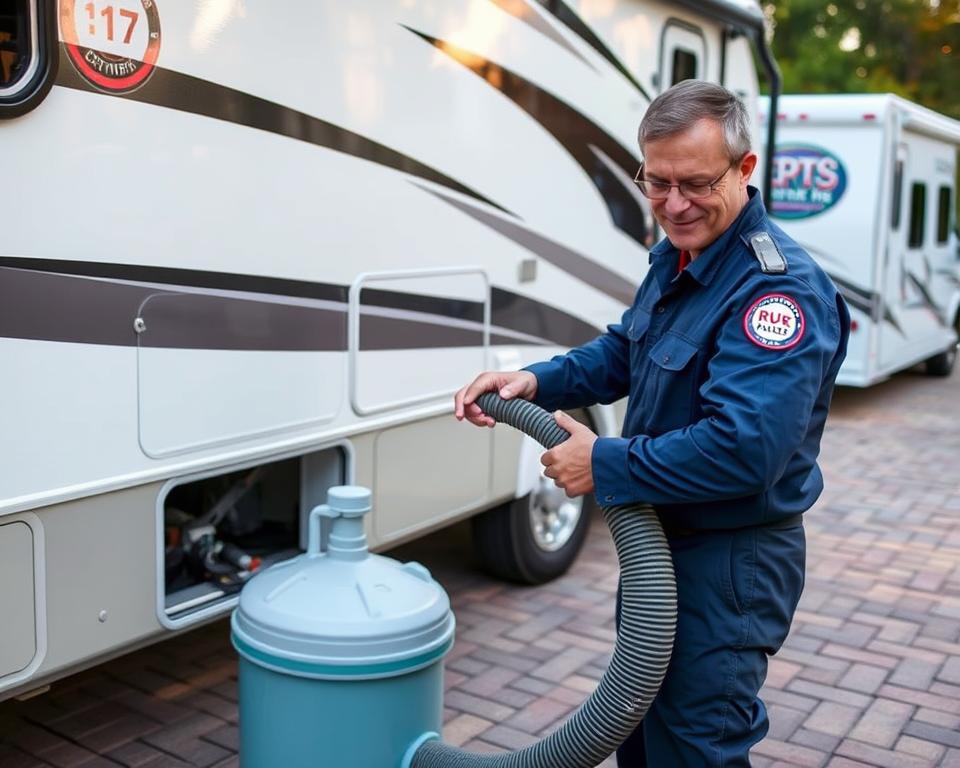Understanding and Maintaining Your RV Black Water Tank Pump
Ever wondered about the impact of the RV black water tank pump on your RVing journey? This pump is a vital component of your RV’s plumbing for waste. To ensure your travels are uninterrupted, proper maintenance is key. You’ll find crucial information in this guide about managing your RV’s waste water pump. Knowing how vital it is will help you improve its efficiency and further enjoy your RV travels.
Main Takeaways
- For proper waste handling, the RV black water tank pump is essential.
- You can extend the life of your RV waste water pump with consistent upkeep.
- If you understand the system’s components, you’ll be better at fixing problems.
- It’s crucial to follow safe dumping procedures for hygiene and environmental reasons.
- Winter preparation of your RV black water tank system helps avoid expensive fixes.
- Maintaining the cleanliness of your RV sanitation pump will help avoid clogs and unpleasant smells.
RV Water Tanks: An Overview
For trouble-free camping with trailer septic tank pumping, it’s possible that many RV owners don’t fully realize the significance of various water tanks. Understanding the roles of the RV fresh water, gray water, and black water tanks is crucial. Each plays a unique role and needs proper care.
The purpose of the RV fresh water tank is to store water that is safe to drink. You use it for drinking, preparing food, and personal cleanliness. The most important thing is to ensure this tank is clean and the water is safe to use. Fresh water is crucial for hydration and health during travels.
In contrast, the RV gray water tank holds the water that has been used in sinks and showers. It’s possible for this tank to fill up fast, so you need to check it often and empty it. For a clean living space in your RV, you must manage the gray water tank appropriately.
As it holds toilet waste, the RV black water tank is of utmost importance. Regular attention is needed to prevent smells and the accumulation of waste in this tank. The condition of the tank and your experience can be enhanced by using suitable tank chemicals. Knowing how to care for each tank makes RV trips more enjoyable.
What is the RV Black Water Tank Pump?
For the sanitation systems of recreational vehicles, the RV black water tank pump is essential. It moves waste to designated disposal sites. For maintenance purposes and to prevent costly fixes, it’s important to understand its function.
There are different types of pumps available for RV owners, such as the sewer pump. The macerator pump is often chosen because it grinds up waste, leading to faster disposal. This is particularly useful when dump stations are crowded.
Waste management in an RV depends on having a quality black tank pump. This helps maintain cleanliness and comfort in the RV. By regularly checking and knowing how your pump works, you can better your RV experience.
The Essential Components of a Black Water Tank System
A key to managing waste efficiently is understanding the RV black water tank system. Many important parts are involved, and they work together to make sure everything runs smoothly. The most vital part is the black water tank, as it holds the waste from the RV toilet. It’s made with durable materials so that it can handle various conditions.

Transferring waste to a specific dump station, the system’s pump is very important. RV owners cannot do without it. Sewer hoses also play a key part, offering a flexible connection between the tank and dump station. The design of these hoses prevents leaks and contains odors, which leads to a clean disposal process.
To attach sewer hoses and allow for efficient waste transfer, connection ports are necessary. Controlling the flow of waste is the crucial role of termination valves. To maintain sanitation, they prevent waste from flowing back and stop spills during disposal.
Getting familiar with these essential components allows RV owners to maintain their sanitation system efficiently. This knowledge is key for troubleshooting issues during travel or use, enhancing the overall RV experience.
Best Practices for Using Your RV Black Water Tank Pump
Using the RV sanitation pump correctly will greatly benefit your RV life. Operating the black tank properly is crucial for ensuring the system works without issues. Thoroughly flushing the tank after each use is a vital step. By doing this, you prevent solid waste from accumulating, which could cause blockages and other difficulties.
Checking your RV sanitation pump regularly makes sure it’s working the way it should. By doing this, you can prevent any unpleasant issues while you’re on the road. Using toilet paper that is designed for RVs is also very important. This type is designed to disintegrate quickly, reducing the risk of creating clogs.
Another important thing to do is to keep the termination valves closed, except when you’re emptying the tank. It assists in preventing the development of odors. Using tank deodorants and cleaners will also help keep the system smelling good and clean. Adhering to these guidelines improves your experience with the RV black water tank.
| Guidelines for Using Your Black Tank Correctly | Pros |
|---|---|
| Ensure Ample Water for Flushing | Prevents solid waste clogs |
| Check the Pump Operation Regularly | Helps ensure it’s working as it should |
| Only Use Toilet Paper Designed for RVs | Decreases the likelihood of clogs |
| Ensure the Termination Valves Remain Closed | Minimizes odors |
| The Use of Tank Deodorants and Cleaning Agents | Helps the system stay clean and smell good |
Top Maintenance Tips for the Black Water Tank Pump
To ensure your RV’s black water tank pump lasts longer and works efficiently, it’s crucial to maintain it regularly. This means you need to use the correct chemical treatments that are designed for these types of tanks. Waste is broken down efficiently by them, and they also prevent odors.
Ensuring an adequate amount of water is used when flushing the toilet is also critical. By doing this, waste can move to the tank without problems, lowering the risk of it building up. Don’t forget to also regularly perform a deep clean of the tank and its components. Use the recommended tools for this important task.
Always monitor the tank levels to avoid any issues. Address leaks or overflows without delay. Regularly emptying the tank is important to prevent the accumulation of solid waste. Having a schedule for maintenance will help make sure your RV experience is problem-free.
| Job for Maintenance | Frequency | Description |
|---|---|---|
| Inspect levels | Each and every trip | Check that the tank isn’t filled beyond capacity to prevent leaks. |
| Treat with chemicals | Following each emptying | Use treatments to help break down waste well. |
| Run a flush of the system | Every month | Apply a cleaning solution to help keep the tank clean. |
| Look over the pump | Prior to extended travel | Examine the pump for any signs of wear or damage to prevent it from failing on the road. |
| Drain the tank | When it’s full | Empty the tank when full, ideally at designated dump stations. |
If you follow these important maintenance steps, your black water tank pump will work properly. This will enhance your RV trips significantly.
Common Black Water Tank Pump Issues and How to Solve Them
It can feel overwhelming to troubleshoot issues with the black tank pump. Many people who own RVs run into various issues with their RV black tanks, such as blockages, leaks, or ongoing bad smells. Learning how to handle these problems when they first appear can save you time and prevent costly repairs.
The first thing to do is check the hoses that are connected to the black tank pump. These areas are where blockages frequently happen, which causes the pump to not work well. Take the hoses apart and look for any buildup or debris inside. If you discover any blockages, ensure the hoses are completely clean before you put them back.
After that, check the seals that are around the pump and the tank. Damaged seals can lead to leaks, and these leaks might not be detected until they’ve caused considerable damage. If you notice any seals that are not working as they should, replace them immediately to prevent future issues.
Enzyme treatments can be helpful for odors that keep coming back. They work by breaking down the waste and reducing the smells that are bothering you. To get the best results, be sure to follow the instructions that came with the product.
For your convenience, here’s a table summarizing common issues and how to solve them:
| Problem | Possible Cause | Fix |
|---|---|---|
| Clogs | Waste material in the hoses or tank | Make sure to check and clean the hoses |
| Escape of fluid | Seals that are not working properly | Make sure to inspect the seals and replace any that are damaged |
| Bad smells | Waste that has accumulated | Use enzyme treatments |
| Pump isn’t functioning | Problems with the power | Make sure the connections are good and check the battery |
Spotting the initial signs of trouble can prevent minor issues from escalating into serious RV black tank problems. Regular upkeep and careful attention will help your black tank pump last longer, which will make better your time in your RV.
RV Black Water Tank Pump Cleaning Techniques
For good hygiene and to keep your RV’s plumbing working well, it’s important to keep the black water tank clean. Rinsing with fresh water after each use helps to minimize odors and ensures everything functions properly. By doing this, you reduce the accumulation of waste and help maintain the tank’s condition.
For a more thorough cleaning, use cleaning solutions that are made for black water systems. These products are good at dissolving waste and fighting bad smells. Fill up the tank with water and the cleaning solution, and then let it sit for a while. Having a built-in flush system in your RV simplifies the cleaning process.
Driving with sharp turns or using sloshing techniques can help to stir up the contents of the tank. It helps to dislodge any residue that might be on the walls of the tank. These cleaning methods help the sensors to be more accurate, which can help you avoid problems with sewage.
How to Dump Your RV Waste Safely at Dump Stations
Knowing how to act properly at RV dump stations is crucial for maintaining a pleasant environment for everyone. When you arrive at the station, ensure your RV is placed correctly. Then, get your gear ready for dumping.
Pay attention to these steps to ensure the process runs smoothly:
- Ensure a firm connection between your sewer hose and the station’s outlet.
- Begin by opening the valve for the black water so the sewage can come out.
- Close the valve of the black tank after it’s empty. Then, open the gray water valve to clean the hose with the less dirty water.
- Once the process is complete, carefully detach your hose to prevent any spillage.
- You should always clean your hoses with drinking water and put them away right away.
It’s also vital that you adhere to the local laws regarding waste disposal. Many places have rules you must obey to protect the environment. If you don’t follow these rules, you could get fines or other penalties.
Showing respect at RV dump stations helps make the experience better for all. Keeping the area clean and following the regulations shows that you respect the community. These actions promote a sense of responsibility among RV enthusiasts and encourage camping habits that are environmentally conscious.
Preparing Your RV Black Water Tank System for Winter
To protect your black water system from freezing, it’s important to winterize your RV tanks. To avoid damage from water freezing within the system, it’s important to prepare correctly. Following a set of specific steps will ensure that your RV black tank receives effective winter care.
- First, make sure to completely drain the black water tank using the appropriate pump and connections.
- Next, bypass the water heater to prevent water from entering and accumulating in the unit.
- Use antifreeze that is designed for RVs, because regular antifreeze can be toxic and damaging to the environment. Pour the antifreeze into the system according to the product instructions.
- Leave all faucets and drains open to allow any remaining water to escape and for the antifreeze to circulate properly.
- Finally, check that all access panels are sealed and secure to prevent water intrusion during winter months.
RV owners can protect their black water tank systems from the harsh effects of winter by following these winterization steps. This proactive approach helps to avoid expensive repairs or maintenance when the seasons change.
To Summarize
A big part of being a successful RV owner is maintaining your RV black water tank efficiently. If you understand how to use the black water tank pump well and follow the maintenance tips in this guide, your travels will be more enjoyable. Taking good care of your equipment will make it last longer and make managing waste in your RV easier. This makes travel less daunting.
Having knowledge about your RV’s black water system is key to addressing problems directly. Using proper maintenance, troubleshooting, and cleaning methods helps to prevent unexpected issues. This lets you enjoy worry-free road trips. Using well-regarded services like All in Sanitation can strengthen your maintenance efforts. You can get the essential products and support for top-quality care from them.
Attentiveness and proper care for every part of your RV, including the black water tank, are part of being a good RV owner. Now that you know this, you’re all set to explore freely. By doing all the right things, you’ve ensured a fantastic trip for yourself and others.


